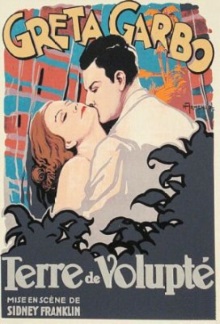
In line with our new interest in cinema, we’ve signed up for another Coursera course called Marriage and the Movies: A History. I suspect that with its focus on marriage it will be more of a sociology class than a movie class but nonetheless we’ll try sticking with it. This means a whole new round of really old movies to watch, starting with this selection from the silent era.
I believe that this is also the first time I’ve watched a movie starring Greta Garbo despite knowing about her legendary reputation since pretty much forever. In Wild Orchids, she stars opposite Lewis Stone who plays her aged husband and Nils Asther who plays the young and handsome prince who tries to woo her away. Interestingly for a course that is all about the institution of marriage, this first pick is about infidelity, or at least the temptation of it.
These three are in fact the only credited cast members since the only other people who appear are servants and drivers. They meet each other while on a voyage to Java, Indonesia. Taken with the beauty of Garbo’s Lillie Sterling, the prince reveals that he owns large tracts of land on the island and invites the couple to stay with him as his guest. The husband, John Sterling finds the offer generous and is excited by the promise of a tiger hunt. Lillie knows that the prince has less than honorable intentions, but as you might expect in a story like this, between her passionless marriage and the prince’s charm, she finds it increasingly difficult to resist.
This movie’s main draw at the time it was made is very obviously its exotic locale. I have no idea if it really was filmed in Java or if it’s just a studio set in Hollywood but it sure looks real enough to me. The scenes in which Prince de Gace shows off the luxurious opulence of his palace, complete with servants who meekly kneel down as he walks by, are designed to impress the audience as much as the couple. Director Sidney Franklin even devotes a full fifteen minutes of screen time to Javanese dances presented as dinner entertainment. If you’re still not convinced that this is truly exotic fare, you will be when Garbo herself changes into a Javanese dress. It’s a great example of how readily Hollywood mines material from all sorts of places and cultures even so long ago.
Apart from this, I find little of note in this film. In fact after watching Street Angel, it’s very evident how the cinematography and the mise en scène here is far inferior. So much so in fact that where in Frank Borzage’s work you simply fall into the emotion as the director intended without really realizing how it was done, here you can see how the director is going for something but instead of feeling the emotion you see instead the craft and the effort visible on the screen. In fact, when you pay attention, the make-up that they put on Asther to make him look like a playboy pervert feels actually comical, which surely isn’t what was intended.
I still found it to be a pretty enjoyable movie and I’m impressed that Hollywood thought to use Java as a setting in the 1920s. The tiger hunt scene was also a good attempt at creating some genuine tension and uncertainty over how things would play out. Of course at the end the film still needs to adhere to the moral standards of the time and I am very curious what the upcoming course will have to say about it.